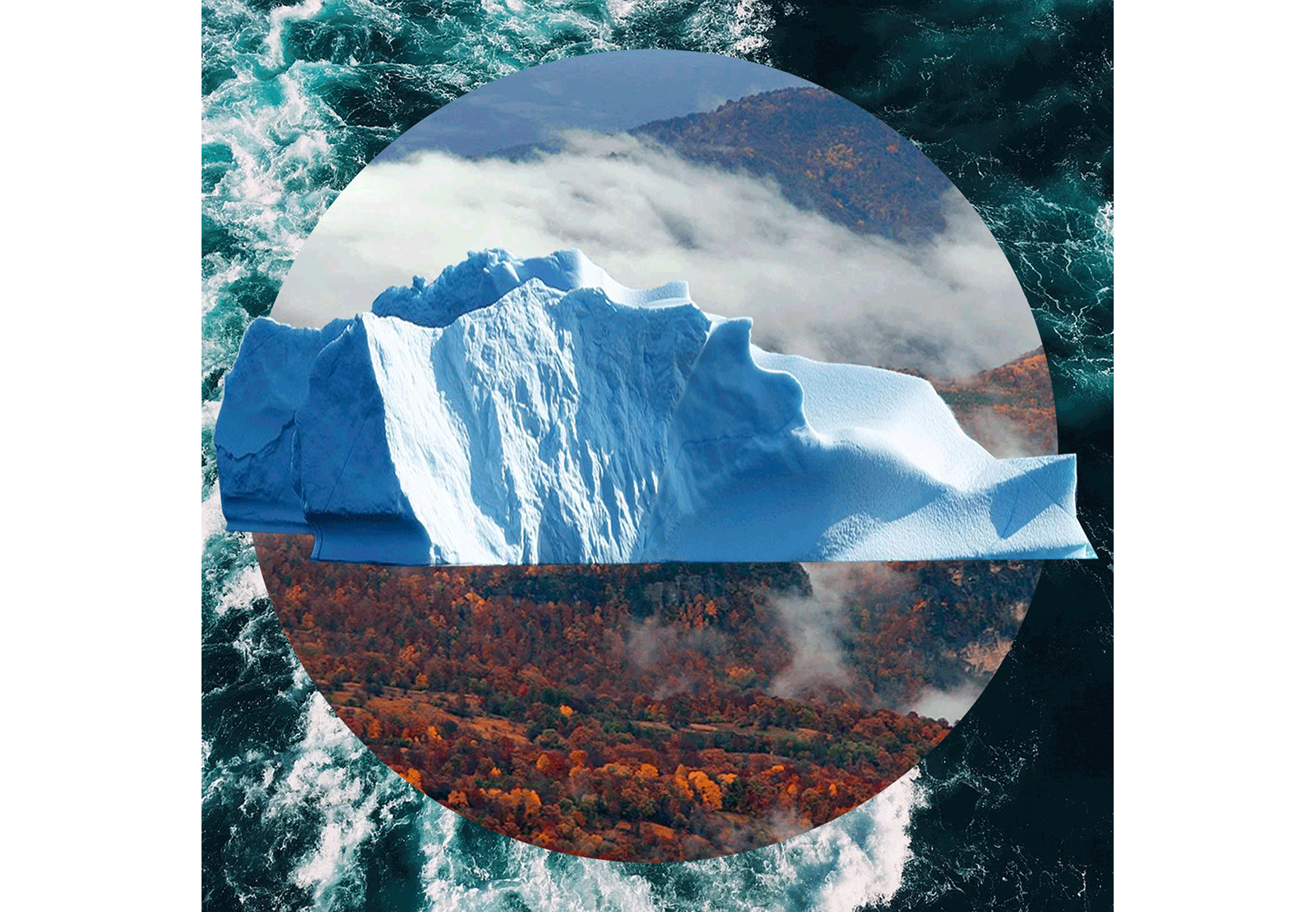As the world warms, these Earth systems are changing. Could further warming make them spiral out of control?
In 2019 an international team of scientists published a commentary in the celebrated science journal Nature, sounding the alarm of a planet in crisis — and calling for transformative change.
“We are in a state of planetary emergency,” they wrote, departing from the usual sterility of scientific writing. “The stability and resilience of our planet is in peril.”
Yes, they were writing about climate change, but of a particular kind: climate tipping points, elements of the Earth system in which small changes in global temperature can kick off reinforcing loops that ‘tip’ a system into a profoundly different state, accelerating heat waves, permafrost thaw, and coastal flooding — and, in some cases, fueling more warming. The planet has already warmed by roughly 1.2 degrees Celsius (2.2 degrees Fahrenheit) since the Industrial Revolution, and if humans keep flooding the atmosphere with greenhouse gases at the same rate, we’re on track to increase that to 2.7 to 3.1 degrees C (4.9 to 5.6 degrees F) by the end of the century.
So those small changes are getting bigger — increasing the likelihood of triggering those reinforcing loops, known as positive feedbacks. (For example, warming increases the frequency of wildfires, which in turn increases the amount of carbon dioxide released into the atmosphere from burning trees, which leads to an increase in global temperature, which means, you guessed it, even more wildfires.)
The scientists identified various elements of the Earth system at risk of reaching points of no return. These elements broadly fall into three categories — ice, sea, and land — and range from the melting of the Greenland ice sheet to the death of coral reefs to the raging of more and more wildfires.
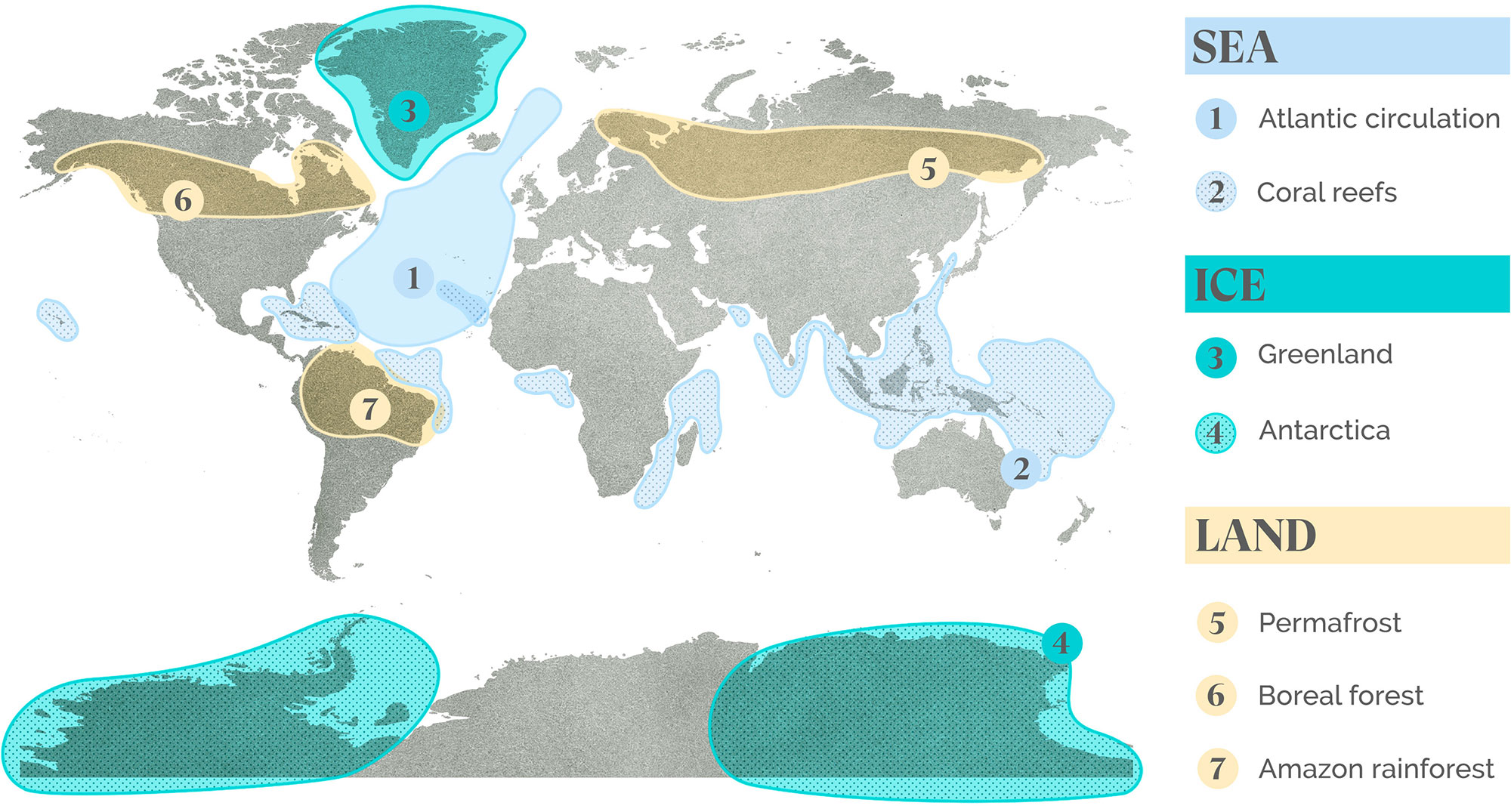
The concept of tipping points challenges the dominant understanding of how climate change fundamentally works, says Will Steffen, one of the Nature article’s co-authors and an emeritus professor of climate science at Australian National University. Rather than a dial slowly turning up, tipping elements could compound, he says, combining to build a greater, planetary-wide tipping point. Alternatively, they could push one element out of whack, triggering another to fall out of phase, and then another in a domino-like effect, resulting in a “rapid acceleration of warming until the Earth stabilizes in another state.” These possibilities are far from certain, he admits, but the consequences of a planetary tipping point are severe enough that even a slim risk needs to be taken seriously.
The particular danger, according to the Nature paper’s authors, is that even though change in a tipping element may happen slowly on a human timescale, once a certain threshold in the system is crossed, it can become unstoppable. This means that even if the planet’s temperature is stabilized, the transition of certain Earth systems from one state to another could pick up speed, like a rollercoaster car that’s already gone over the apex of a track.
Jacquelyn Gill is a paleoecologist at the University of Maine who studies physical records of Earth’s ancient climate. She didn’t work on the Nature paper, but she says the evidence from Earth’s history supports the idea of nonlinear climate responses, and that understanding this evidence can help us better understand what might lie ahead. “It’s not just the matter of more CO2 equals more warming,” Gill says. “There will be feedbacks.”
For Steffen and his co-authors, including Tim Lenton, the director of the University of Exeter’s Global Systems Institute, understanding the risks of tipping points requires a radical reframing of the climate challenge — and a more fundamental shift in human society than merely pumping successively fewer and fewer emissions into the atmosphere. “If we’re right about the tipping points, they’re not marginal,” Lenton tells Grist. “They’re existential risks.”
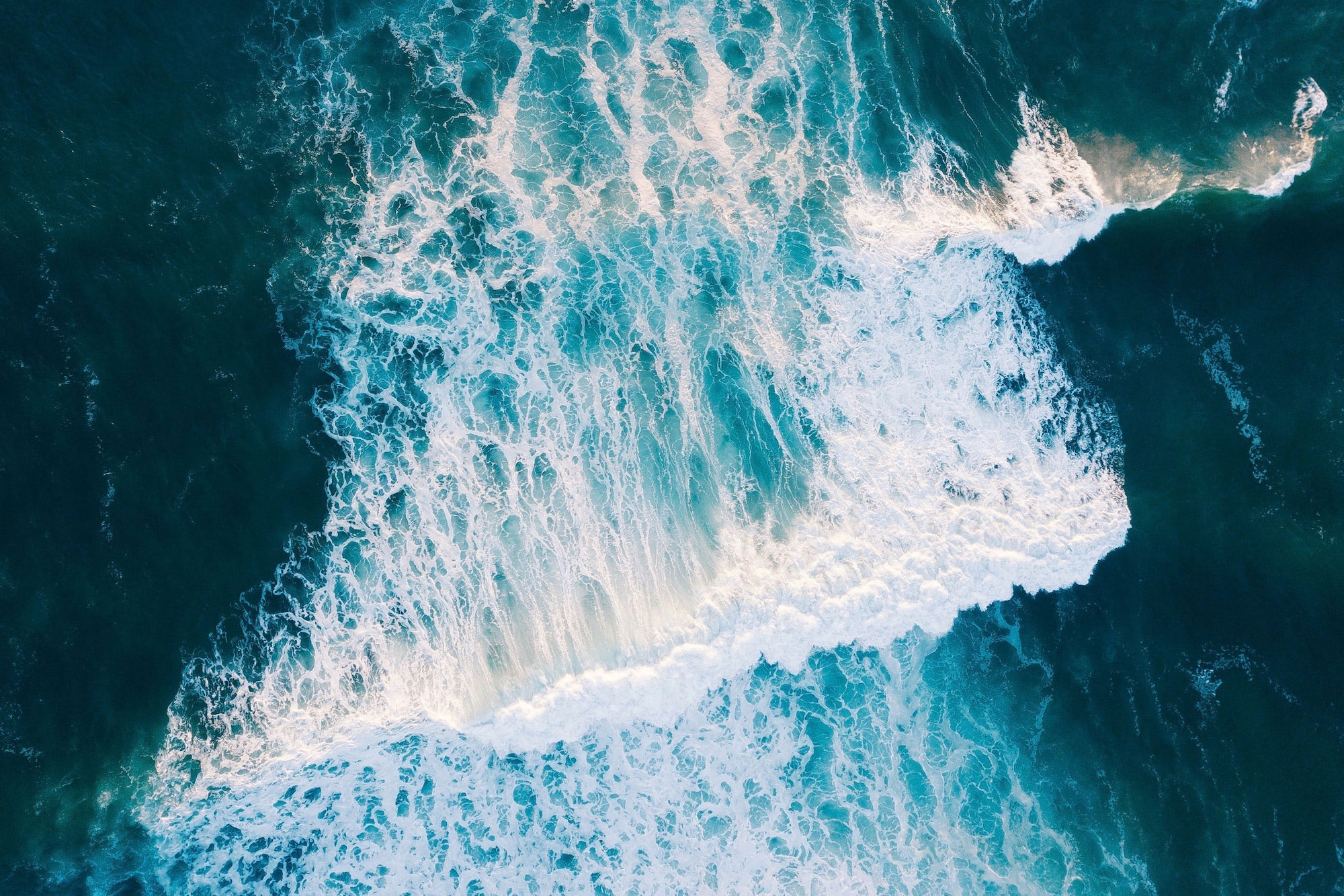
Sea
When it comes to the climate crisis, the sea is both an unwitting ally and frequent victim. The world’s five oceans — which cover 70 percent of its surface — absorb both heat and carbon dioxide, gobbling up at least a quarter of the emissions dumped into the air from the burning of oil, gas, and coal. Without them, the world would have already warmed so much, it would be virtually uninhabitable by humans.
But all that absorption comes at a cost. As heat rises, ice melts, and carbon dioxide pours into the ocean, ecosystems are thrown into disarray. Coral reefs are overheated, withered by extreme temperatures and dissolving in acidified waters. Currents that have been stable for millennia are starting to shift and change, inching toward collapse. In the far reaches of the North Atlantic and across broad swaths of the tropics, some climate tipping points may already be underway.
Atlantic Ocean circulation
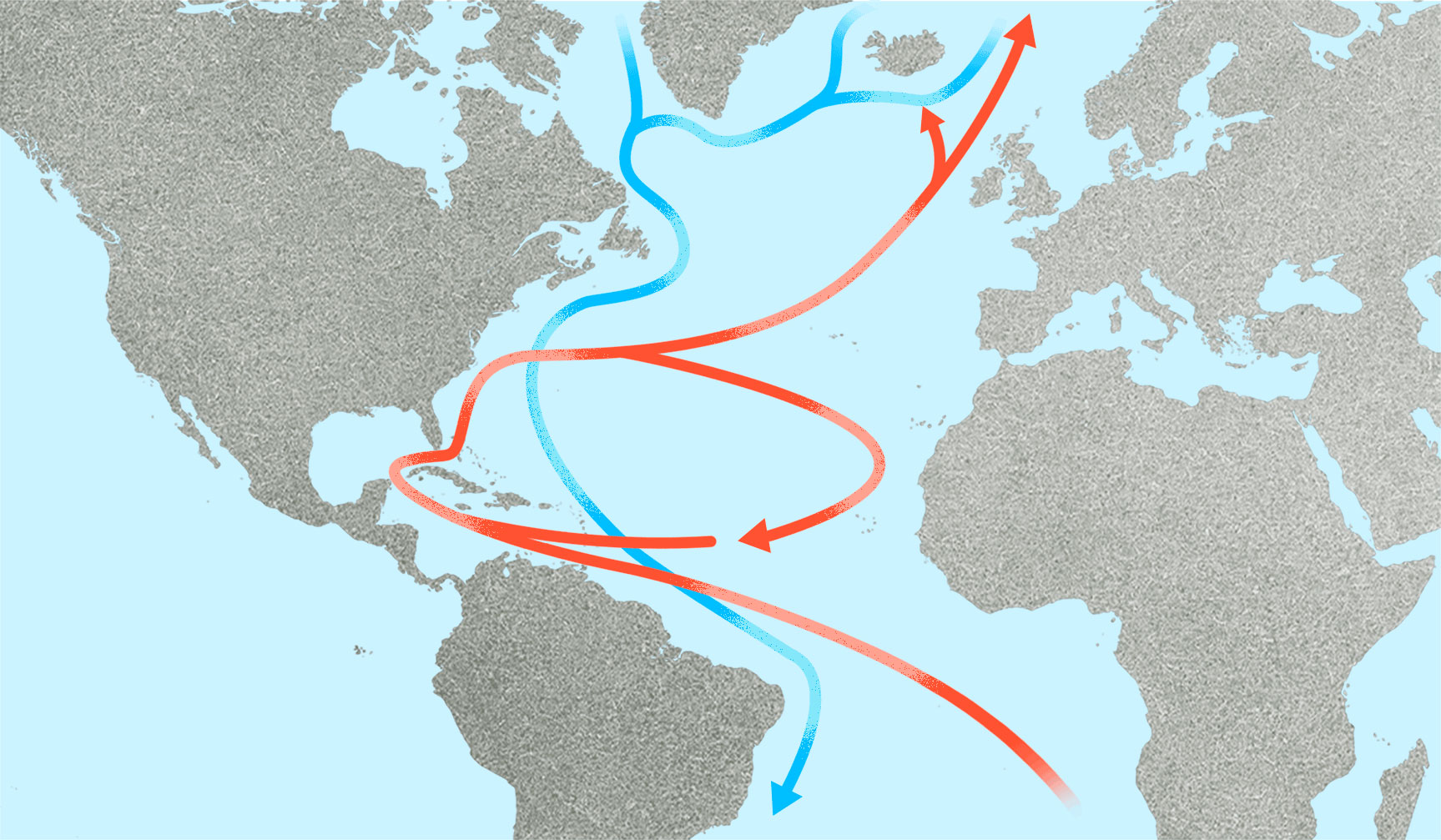

Early in the 2004 film The Day After Tomorrow, climate scientist Jack Hall — played by a concerned-looking Dennis Quaid — receives a late-night phone call. It’s a fellow scientist he’d recently met at a conference. “You recall what you said in New Delhi, about how polar melting might disrupt the North Atlantic current?” the scientist asks. “Well …” the scientist continues, his voice trailing off. “I think it’s happening.”
What follows is hardly scientifically accurate — it’s a Hollywood movie, after all. As a consequence of that disrupted current, tornadoes sweep across Los Angeles and a tsunami-like wave crashes into New York City. But while most of the film belongs in the realm of sci-fi (or “cli-fi”), the movie’s central premise — that the collapse of one ocean current could have knock-on effects for the rest of the world — is true.
The Atlantic Ocean is dominated by a single current: a thick band of water that flows north from the Gulf of Mexico, hugs the southeastern coast of the United States, and then shoots up north toward the frigid outposts of Greenland and Iceland. Along the coast of the U.S., where the current is known as the “Gulf Stream,” the water is warm — in the summer, it can reach a balmy 71 degrees Fahrenheit — but as it winds its way northward it gets colder and colder, releasing huge amounts of heat into the atmosphere. This current — known as the “Atlantic meridional overturning circulation,” or AMOC for short — keeps the weather mild in cities like Berlin, London, and Paris, and scientists estimate that the energy it transports is roughly equivalent to the power provided by 1 million average-sized nuclear plants.
The AMOC relies on a mechanism that happens off the coast of Greenland.
There, the waters of the current get so heavy, cold, and salty that they plunge to the ocean floor.
But as the planet warms and Arctic ice melts, billions of tons of freshwater are pouring into the ocean.
That freshwater dilutes the current and makes it lighter — and less likely to sink.
In the short term, that means the AMOC could slow down.
In the long run, it may grind to a halt completely.
“This is not just a theory,” says Stefan Rahmstorf, a climatologist at Potsdam Institute for Climate Impact Research in Germany. “It has happened repeatedly in the history of the Earth during the last ice age.”
A collapsed Atlantic current could cause plummeting temperatures in the northern hemisphere, an extra foot and a half of sea level rise along the East Coast of the U.S., and more ferocious winter storms over Europe, according to modeling from the U.K.’s national weather service. Scientists say it could also rejigger agriculture, by mutating precipitation patterns around the world, endangering crop yields in Great Britain and Ireland, which would become more arid and cold.
While scientists know that the Atlantic current could shut down, nobody has a clear idea of when it could happen. In its 2014 summary of the state of Earth’s climate, the United Nations Intergovernmental Panel on Climate Change, or IPCC, said it was “very unlikely” that the current would collapse during the 21st century, but that it was too difficult to predict what would happen after 2100. Other papers have estimated that the current could come to a stop with anywhere between roughly 3 and 5.5 degrees C (5.4 and 9.9 degrees F) of global warming.
“If we stay below 2 degrees Celsius (3.6 degrees Fahrenheit) of global warming, then it really is highly unlikely that we will have an AMOC shutdown,” says Levke Caesar, a researcher at Ireland’s Maynooth University. “But if we have other degrees of warming, we don’t know.”
According to Caesar’s own research, the Atlantic circulation has slowed since the mid-20th century, and now carries around 15 percent less water than it once did. In another study, released in February, scientists argued that the current is at “its weakest state in over a millennium.” A particularly dramatic slowdown from 2009 to 2010 was linked to an icy winter in western Europe and an abrupt spike in sea-level rise along the East Coast. (Some scientists, including Caesar, suspect the current pulls water away from the eastern seaboard; when it slows down, the ocean waters surge up again.) Thomas Delworth, a senior scientist at the Geophysical Fluid Dynamics Laboratory in Princeton, New Jersey, says that by 2100, the current could weaken by 30 to 60 percent — but “there’s still a lot of uncertainty.”
Even a total shutdown of the Atlantic current wouldn’t happen overnight like in The Day After Tomorrow. Rahmstorf characterizes a potential collapse as more of a “winding down” that would take place over 60 to 100 years. But that “winding down” would drive wild weather changes, rising sea levels, and chilling temperatures from Spain to Scandinavia. And, like many scientists, Rahmstorf won’t rule out the possibility of an earlier shutdown.
“If you say we are 90 percent sure nothing serious will happen by 2100 to the AMOC, that sounds reassuring to people,” he says. “But it’s not reassuring to me. A 10 percent risk is far too big.”
Coral reefs
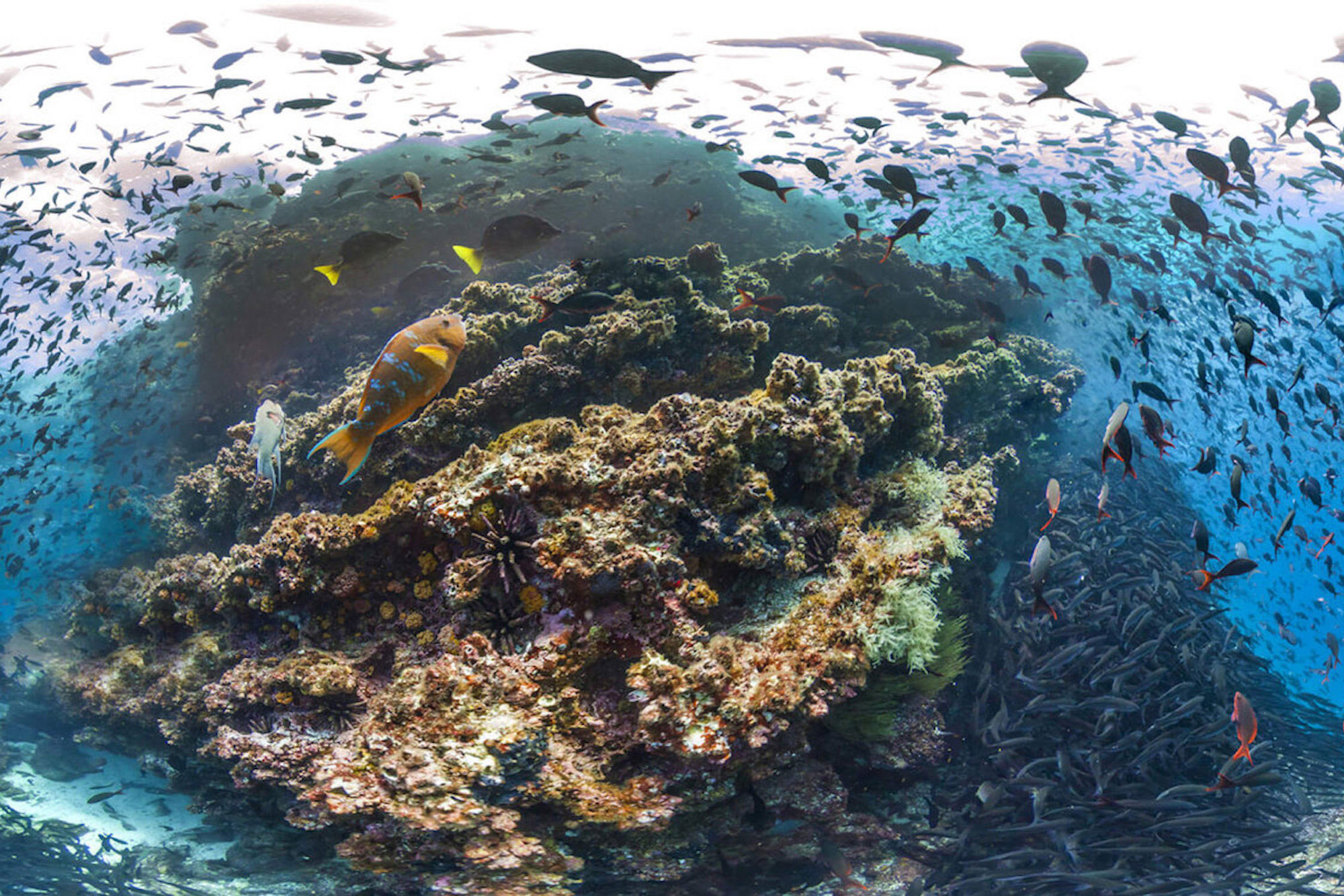
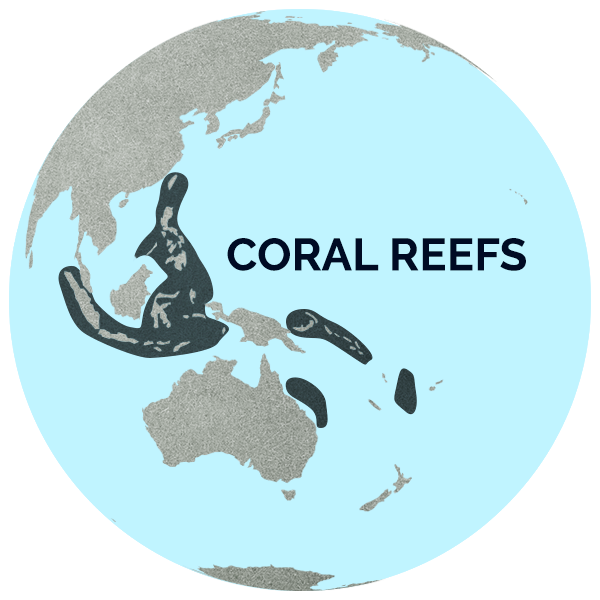
Steph Gardner was nearing the end of her doctorate when the coral reefs she researched bleached for the first time. Her field sites were scattered along the Great Barrier Reef off the northeast coast of Australia — sections of the ocean that had begun to feel as familiar to her as the hallways of her own home. She knew where the large acropora coral was, with its hundreds of pointy fronds; she knew to make a right turn at a large, lumpy pillar called a bommie.
But this time, something was amiss. A marine heat wave had surged across the Pacific Ocean, dialing the water to 86 degrees F — the same temperature as a warm bath. Gardner’s fellow researchers were coming up from the reef with tears in their eyes: The coral below had turned a ghostly, almost fluorescent white. “It was just like seeing a graveyard — absolutely gut-wrenching,” says Gardner, who is now a researcher at the University of New South Wales in Sydney.
That was in 2016, the year of the largest and most devastating coral bleaching event in history. More than half of the corals in the northern, 435-mile-long stretch of the Great Barrier Reef died — some immediately, cooking in temperatures 4 to 7 degrees F above average. Others slowly starved over a period of months. And the bleaching wasn’t confined to the coast of Australia. All over the world, reefs were turning white and dying off. Then, in 2017, it happened again. And then again in 2020.
“From my perspective,” Gardner says, “we’ve already reached a tipping point.”
Corals are strange creatures: minuscule animals that house tiny, friendly plants within their flesh and tentacles. In exchange, the plants help feed the coral, tinting their hosts a dusty pink or brown. But when water temperatures rise around 1 to 2 degrees C (1.8 to 3.6 degrees F) above average, that previously happy relationship breaks down. The plants rebel, spitting out toxic levels of oxygen. In response, the corals hastily jettison them, losing their color and standing out starkly bone-white against the rest of the reef — a process known as “bleaching.”
A reef can survive if cooler temperatures return quickly, returning coral-feeding plants to their homes. Without them, many corals starve to death, their skeletons swallowed up by thick tufts of what looks like dark green fur. The “fur” are colonizing species of algae, which take over reefs when corals crumble. “What was once a living, vibrant reef becomes a reef of skeletons,” says David Kline, a coral scientist at the Smithsonian Tropical Research Institute in Panama. “It becomes a morgue, covered over with slimy algae.”
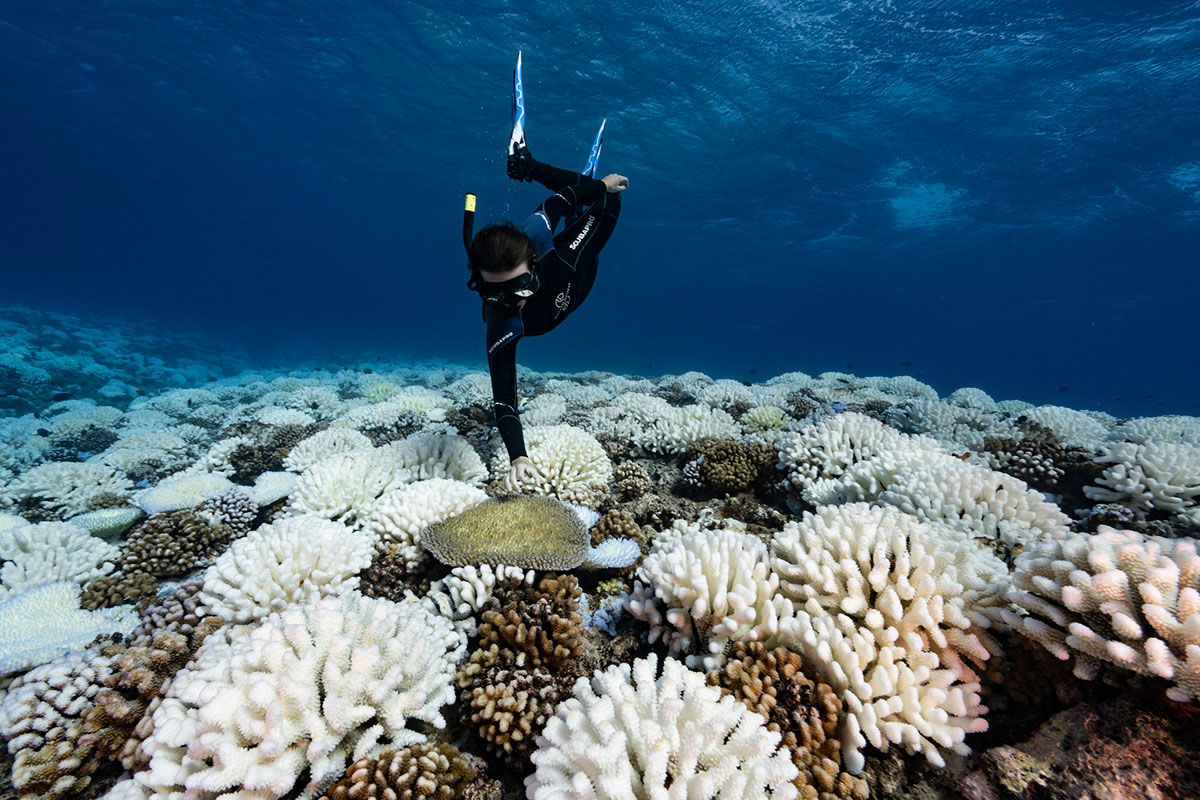
It’s hard to identify a single, global tipping point for corals: Each reef is different, accustomed to different temperatures and living with different sources of stress. One reef, exposed to record-high temperatures, might die in a matter of weeks, already overwhelmed by an influx of smothering algae. Another might survive, protected by cold water welling up from the ocean floor. But as the planet warms, the ocean warms with it — and eventually most coral reefs will pay the price.
A healthy reef can take 10 to 15 years to return to normal after a catastrophic heat wave, but severe bleaching is now occurring every six years. According to the IPCC, 70 to 90 percent of coral reefs could disappear even if average temperatures remain under 1.5 degrees C (2.7 degrees F) of global warming. At 2 degrees of warming, nearly all of them — 99 percent — would vanish.
And it’s not just rising temperatures that threaten the reefs. The ocean absorbs more than a quarter of the carbon dioxide humans spew into the atmosphere, and all that gas makes the water sharply acidic. If the pH of a reef drops too low, its corals won’t just be overwhelmed by heat — their skeletons could start dissolving.
Ove Hoegh-Guldberg, a professor of marine studies at Australia’s University of Queensland, says current rates of warming could soon make the planet inhospitable for reefs. “I believe you get to a point where the odds are so stacked, and the corals are so sick and poor, that we’re just not going to have coral reefs anymore,” he says.
That could be catastrophic for the millions of people who depend on reefs around the world. Despite covering less than 2 percent of the ocean floor, corals’ complex structures house around a quarter of the planet’s marine species. They also provide food, income, and storm protection for approximately 500 million people.
Despite the odds, scientists are continuing to help reefs recover any way they can, engaging in a Noah’s Ark-type attempt to rescue — and re-introduce — as many corals as possible. Some are cross-breeding corals, trying to develop species that can withstand record-high temperatures and acidity; others are visiting distant coral outposts, like hot mangrove lagoons, to better understand how so-called “supercorals” are already surviving some of the most challenging conditions in the world.
“We’ve shifted into an emergency mindset,” Kline says. “If we don’t actively try to protect coral reefs, things are really going to change for the worse.”
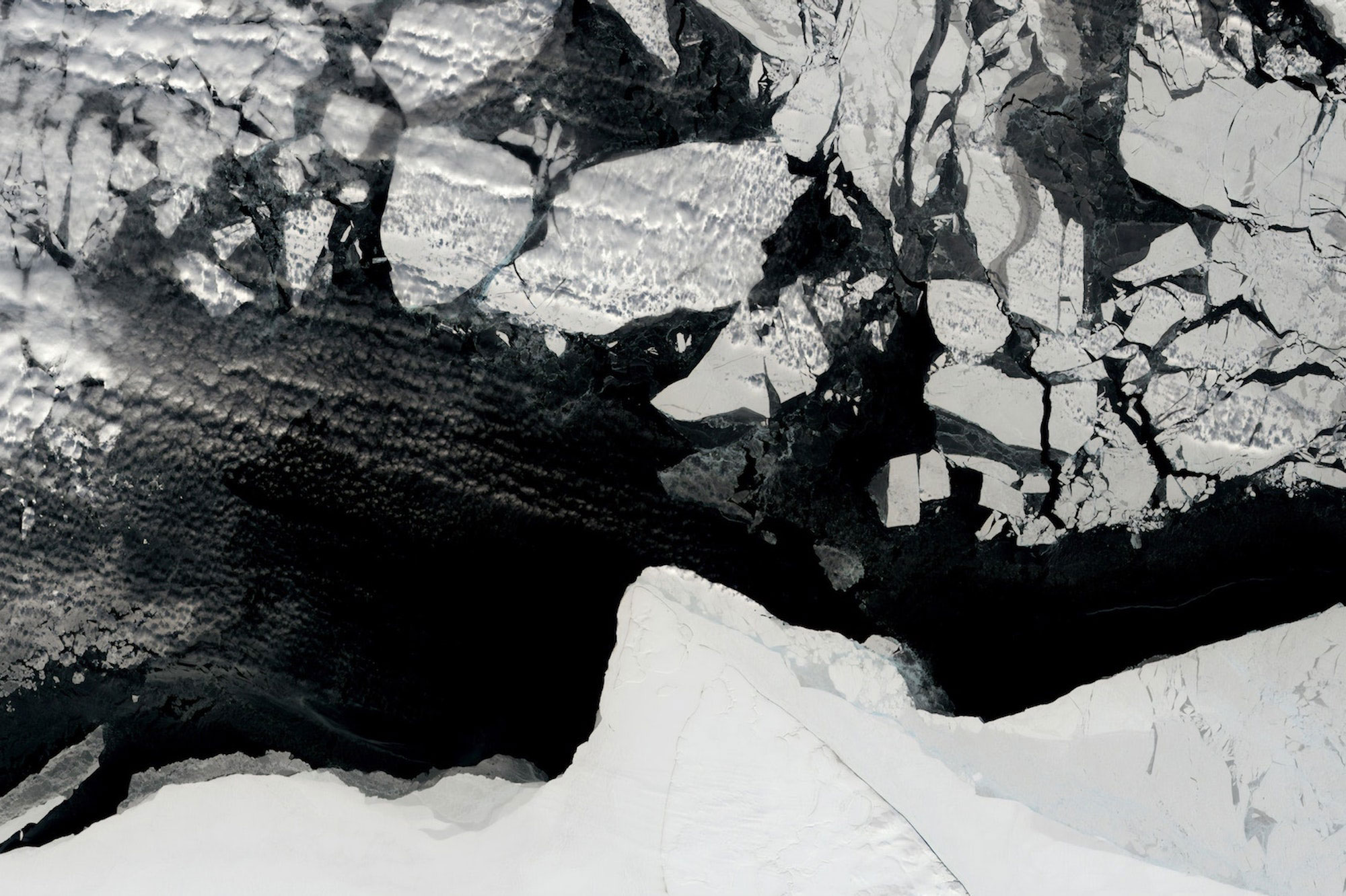
Ice
The Greenland ice sheet in the high Arctic and the Antarctic ice sheet that encircles the South Pole combine to hold 99 percent of the world’s freshwater. If all of that water emptied into the sea, the oceans would rise hundreds of feet, permanently redrawing Earth’s coastlines.
A growing body of evidence from Earth’s geologic past shows that both ice sheets can melt rapidly when something — or someone — fiddles with the thermostat. Both appear to have tipping points that could lead to runaway ice collapse and irreversible sea-level rise. But reaching those thresholds varies dramatically from one pole to the other as a result of stark differences in the atmosphere and ocean currents surrounding each pole, as well as the geometry and scale of the two ice sheets.
Both ice sheets are effectively a vast mountain of ice draped over a continent (Antarctica) or a giant island (Greenland). Ice flows off these frozen mountains and into the surrounding seas through hundreds of enormous, frozen rivers, known as outlet glaciers. In parts of Greenland where outlet glaciers meet the ocean, the water is warm enough that these glaciers immediately start to melt and break up. But in the much colder seas surrounding Antarctica, they’re often buttressed by floating ice shelves. Like corks in champagne bottles, these shelves help hold back the land-bound ice behind them — unless warming water starts to shake the shelves loose.
Greenland
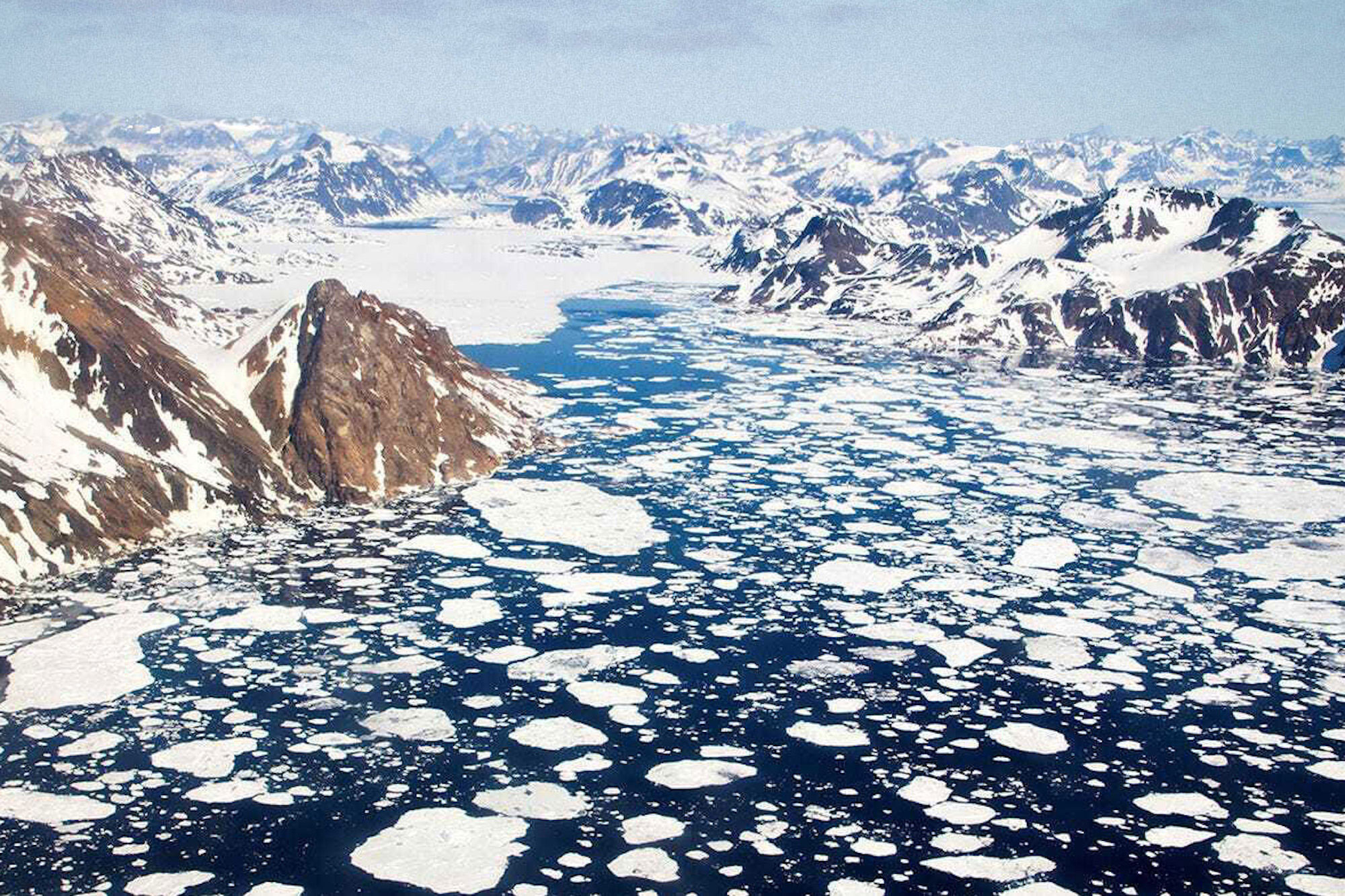
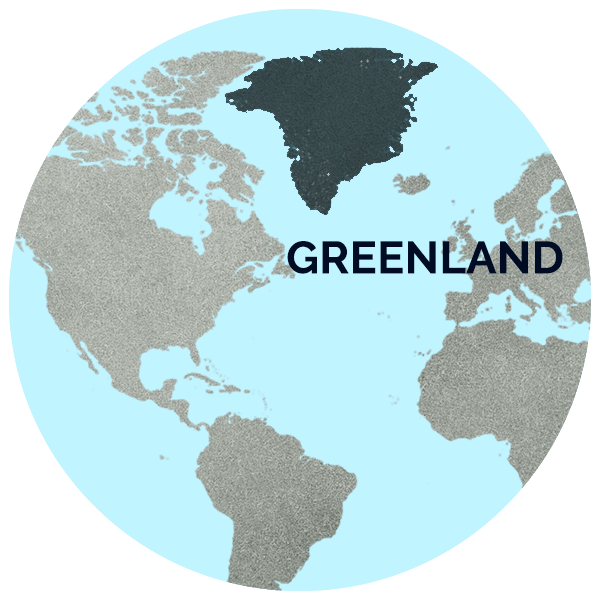
It was early one May when Santiago de la Peña realized something wasn’t right. The glaciologist had just hiked to Russell Glacier, located about 20 miles inland of Greenland’s west coast. At that time of year, the glacier should have been frozen solid. But a river of meltwater had formed across its surface, creating a series of enormous waterfalls.
A landscape that should have been silent was reverberating with the roar of freshly melted ice making its way toward the sea. “I’d never seen so much meltwater at that time of year,” says de la Peña, who has worked at field sites in western Greenland for the past decade.
That was 2019 — a record year for the loss of Greenland’s ice. After an unusually warm spring followed by a late July heat wave that caused nearly the entire ice sheet’s surface to start melting, Greenland would go on to shed 532 billion tons of ice into the sea that year. As a result, global sea levels are now permanently 1.5 millimeters (0.06 inches) higher.
A total meltdown of Greenland’s ice sheet would raise sea levels much higher still — by about 24 feet. Though scientists estimate that it would take at least a thousand years for Earth’s second-largest ice sheet to melt completely, years like 2019 are a reminder that Greenland is already undergoing a massive transformation with planet-wide consequences. Between 1992 and 2018, Greenland shed nearly 4 trillion tons of ice, and researchers worry that if carbon emissions continue to rise it could pass a point of no return within decades.
There are two key phenomena behind Greenland’s melting — and if they accelerate and if future feedback loops amplify them, the ice sheet could plunge into a state of irreversible loss. One is mild summer weather and a warming atmosphere melting the sheet’s surface, causing water to pool and run downhill into the sea. The thawing of fresh, white snowfall exposes darker, bare ice, which absorbs more of the sun’s energy, triggering more melting.
The other is around Greenland’s coasts, where rising ocean temperatures are destabilizing the edges of glaciers that funnel ice into the ocean. As these gateways break up, the frozen rivers they hold back start flowing faster into the surrounding sea.
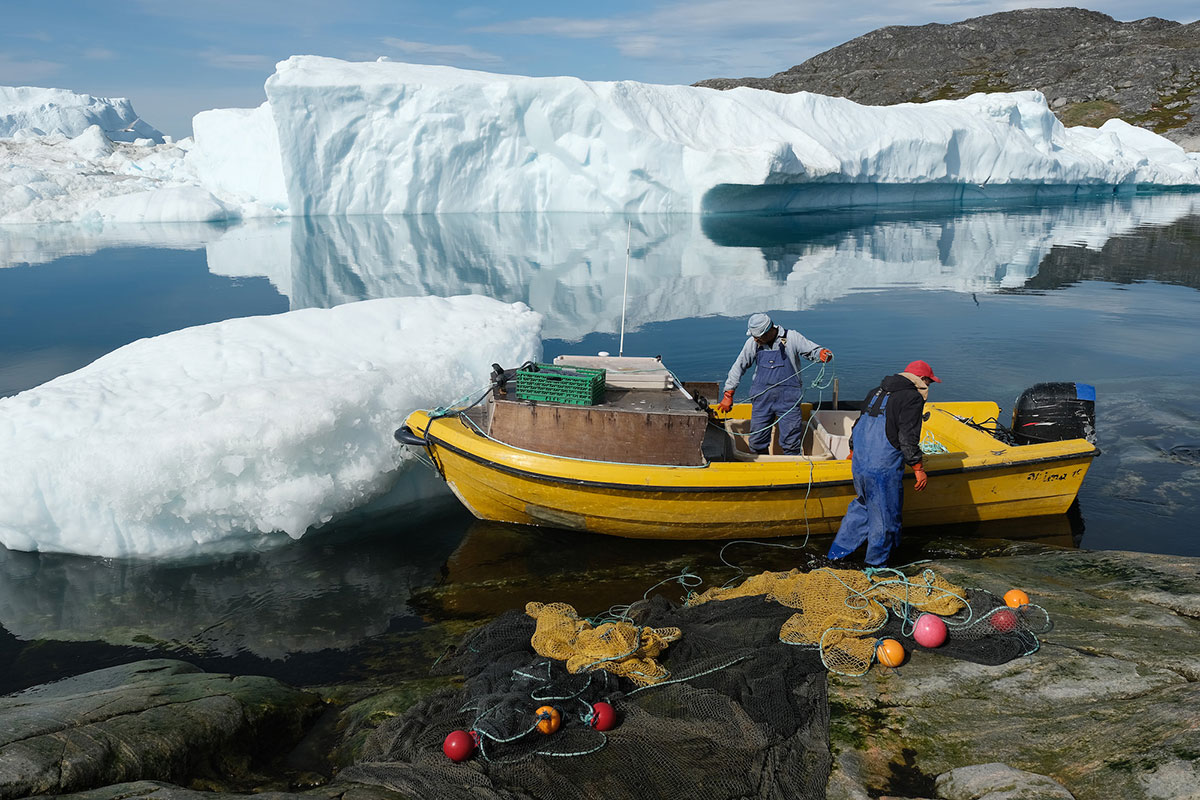
Over the last 30 years, heat in the ocean and in the atmosphere has contributed roughly equally to Greenland’s slimdown. But in recent years, the atmosphere has taken a larger role, as summertime heat waves supercharged by climate change trigger melt events like Greenland saw in 2012 and 2019. If those become the norm, dangerous feedback loops could kick in. One that’s particularly troubling: As Greenland’s surface melts, the ice sheet’s elevation drops like a popsicle flattening onto a pavement. And as surface elevation falls, surface air temperatures rise, resulting in more melting.
Taken together, all of these processes could tip the ice sheet into a state of irreversible meltdown. One recent modeling study that looked only at surface melt found that 2.7 degrees C (4.9 degrees F) of global warming could push Greenland into a state of “sustained mass loss” — an effect known as “climate forcing” — where meltwater runoff exceeds snowfall accumulation year after year. But other models that consider both surface melt and coastal glacier retreat suggest Greenland’s true tipping point might be as low as 1.6 degrees C (2.9 degrees F) — merely 0.4 degrees C (0.7 degrees F) above the current level of warming.
“Unless we figure out a way to rapidly reverse climate forcing, my opinion is that the ice sheet’s doomed,” says Ian Howat, a glaciologist at Ohio State University. Research Howat co-authored last year suggests that Greenland already passed a mini tipping point in the early 2000s, when dozens of coastal glaciers simultaneously started to retreat.
It’s still possible, however, that we can lower our emissions quickly enough to prevent the ice sheet from entering full-on meltdown mode. It’s also possible that Greenland’s ice actually has no tipping point: In contrast to earlier work, a modeling study published in December found that negative feedbacks, like increased snowfall over Greenland’s remaining ice as the ice sheet contracts, could prevent a runaway collapse and allow Greenland to restabilize at a smaller “steady state.” Scientists are still investigating why some models predict this, though it may be that as the ice sheet retreats inland and Greenland’s coastlines become flatter, moist marine air is able to migrate further inland before it rises and condenses into clouds, which can then produce snow.
Even in a catastrophic meltdown scenario, “we have to remember it’s going to take a long time to lose the Greenland ice sheet,” says Ruth Mottram, a climate scientist and glaciologist at the Danish Meteorological Institute. And how long exactly that process takes depends on our carbon emissions. A 2019 paper found that under a high-emissions scenario, the entire Greenland ice sheet could disappear within a thousand years. Under a moderate emissions trajectory, the ice could hang on for a few thousand more.
“It looks very different if we lose all of the Greenland ice sheet in the next one thousand years versus if we lose all of it in the next ten or twenty thousand years,” says Twila Moon, a glaciologist at the National Snow and Ice Data Center. “We can decide we don’t want to lose as much ice as quickly.”
Antarctica
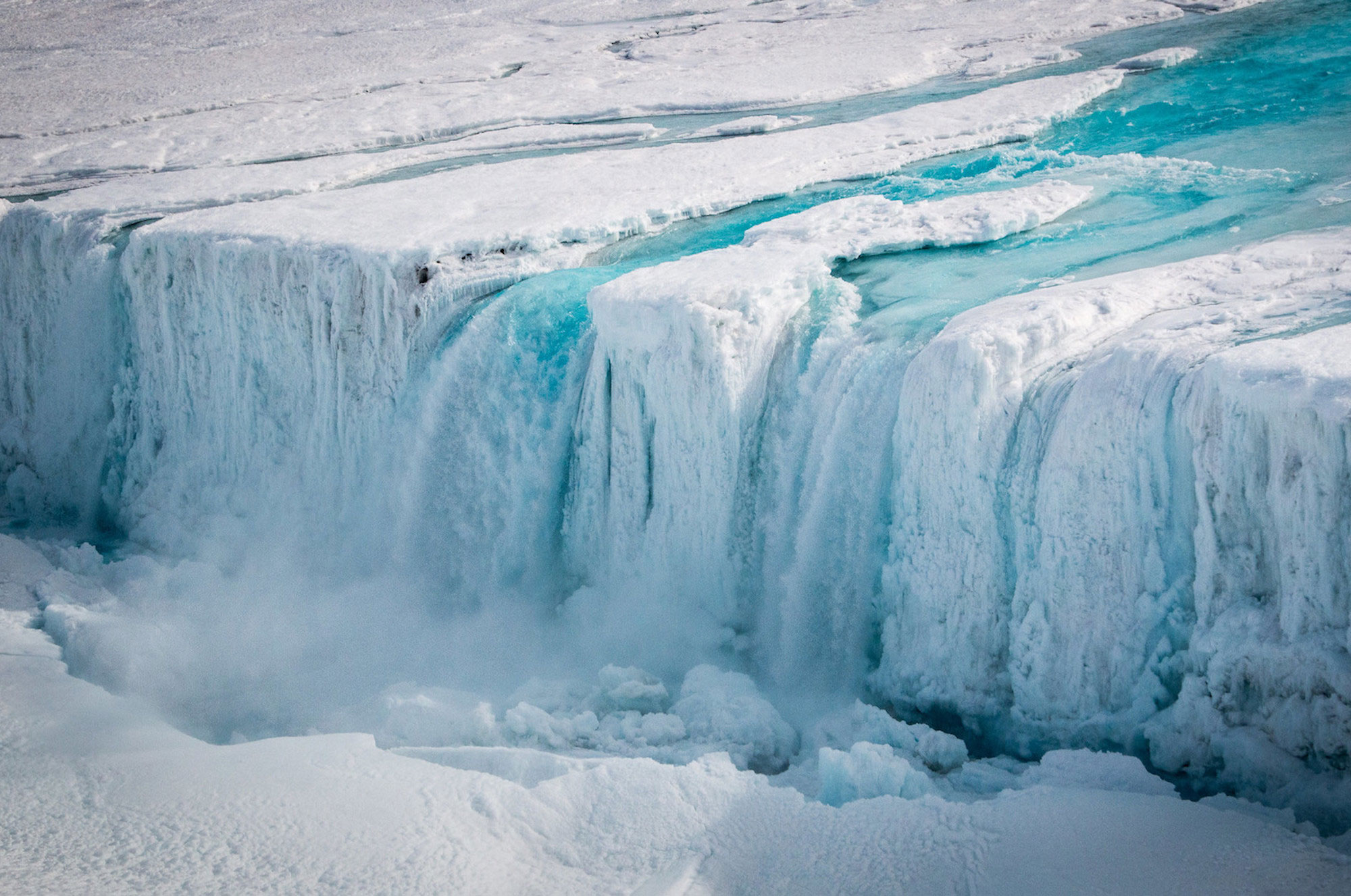

Ted Scambos has studied Antarctica for decades. But in December 2019, he saw the ice sheet’s future with his own eyes.
He had just arrived at the remote shores of West Antarctica’s Amundsen Sea, and his team had set up a field camp on the floating ice shelf that holds back Thwaites Glacier. Looking inland and uphill at the vast, frozen river that wends its way into the heart of West Antarctica, Scambos could see giant icy crevasses stretching across the horizon, like cracks in a wall on the brink of collapse.
“The sense of scale, of this huge region pushing towards the sea, actually gives one a feeling of unease,” recalls Scambos, a glaciologist at the University of Colorado, Boulder. “You can feel the threat, live and in person.”
Since the early 2000s, Thwaites, also known as the “Doomsday Glacier,” has dumped a trillion tons of ice into the sea. Scientists like Scambos believe it may be in the early stages of an irreversible collapse, which could take out a large portion of the West Antarctic ice sheet, raising global sea levels by at least 2 feet, and perhaps more than 10.
A race is now on to determine whether Thwaites has already crossed such a tipping point, and whether some of the larger coastal glaciers rimming East Antarctica will be similarly imperiled if global warming continues unabated.
The reason Thwaites is particularly unstable has to do with its shape.
The bottom of the glacier is anchored to an ancient seabed — a point called a grounding line, where ice, rock, and ocean meet.
As one moves inland on Thwaites, the bedrock below it gets deeper.
Warm ocean water is weakening the undersides of the floating ice shelves that support Thwaites.
That pushes the grounding line inland, leaving progressively thicker slabs of ice floating unmoored.
The edges of the shelf have a harder time holding back thicker floating ice, and so the entire glacier starts flowing faster into the sea. This triggers even more retreat in a runaway process known as the “marine ice sheet instability.” According to Scambos, “That runaway situation may already be started at Thwaites.” He adds that there are only “one or two regions left” where the bedrock rises and could potentially stabilize the glacier as it retreats inland.
The warm ocean water that’s causing so much trouble for Thwaites is part of a deep, salty ring that encircles the continent. Today, a recent strengthening of the westerly winds that whip around Antarctica is pushing more of this warm water toward Thwaites where it can attack the underside of the glacier.
Even if we were to shut down all carbon emissions today, it’s unlikely we could completely shut off the processes causing Thwaites to retreat: “It’s just going to be a component of how the Earth works for the foreseeable future,” Scambos says, “meaning millennia.”
But not everyone is convinced that Thwaites is doomed. “I don’t think we know enough to say we have reached a tipping point,” says Indrani Das, a glaciologist at Columbia University. “Our observation period is not long enough to assess irreversibility.”
What’s more, even if a runaway scenario is underway, we can still slow it down by slashing emissions rapidly. Scambos notes that avoiding more than 2 degrees C (3.6 degrees F) of global warming could make a big difference. “It still runs away,” he says, “but it’s much slower.”
While glaciologists have suspected for decades that Thwaites and the surrounding West Antarctic ice sheet are in a precarious position, East Antarctica’s much larger and colder mantle of ice was long considered stable, at least by comparison. East Antarctica holds enough frozen water to lift sea levels up by 170 feet compared with West Antarctica’s 16 feet. But over the past decade, the assumption that most of that ice will remain put has begun to fade, according to Howat, the Ohio State University glaciologist. Improved maps of the continent have revealed that large portions of East Antarctica, including major sections of the ice contained inside Totten and Denman glaciers and the Wilkes Basin, are also anchored on deep, reverse-sloping bedrock that may be prone to marine ice sheet instability.
While East Antarctica’s deep-rooted glaciers “seem to be further away from reaching the tipping point for now,” as Scambos puts it, continued ocean warming and circulation of warm, deep water beneath their protective ice shelves could eventually destabilize them. A 2014 modeling paper found that removing a comparably small “plug” of ice from the shelf buttressing the Wilkes Basin — equivalent to just 3 inches of sea-level rise — could be enough to tip off a runaway collapse that adds up to 13 feet to global sea levels. Recent airborne and satellite remote sensing surveys, meanwhile, reveal that both Totten and Denman Glaciers are already retreating at their grounding lines. The collapse of Totten would add the equivalent of another 13 feet of sea-level rise; Denman would add another 5.
“This accounts for a lot more sea level potential than West Antarctica,” says Helen Fricker, a glaciologist at the Scripps Institution of Oceanography in San Diego, California.
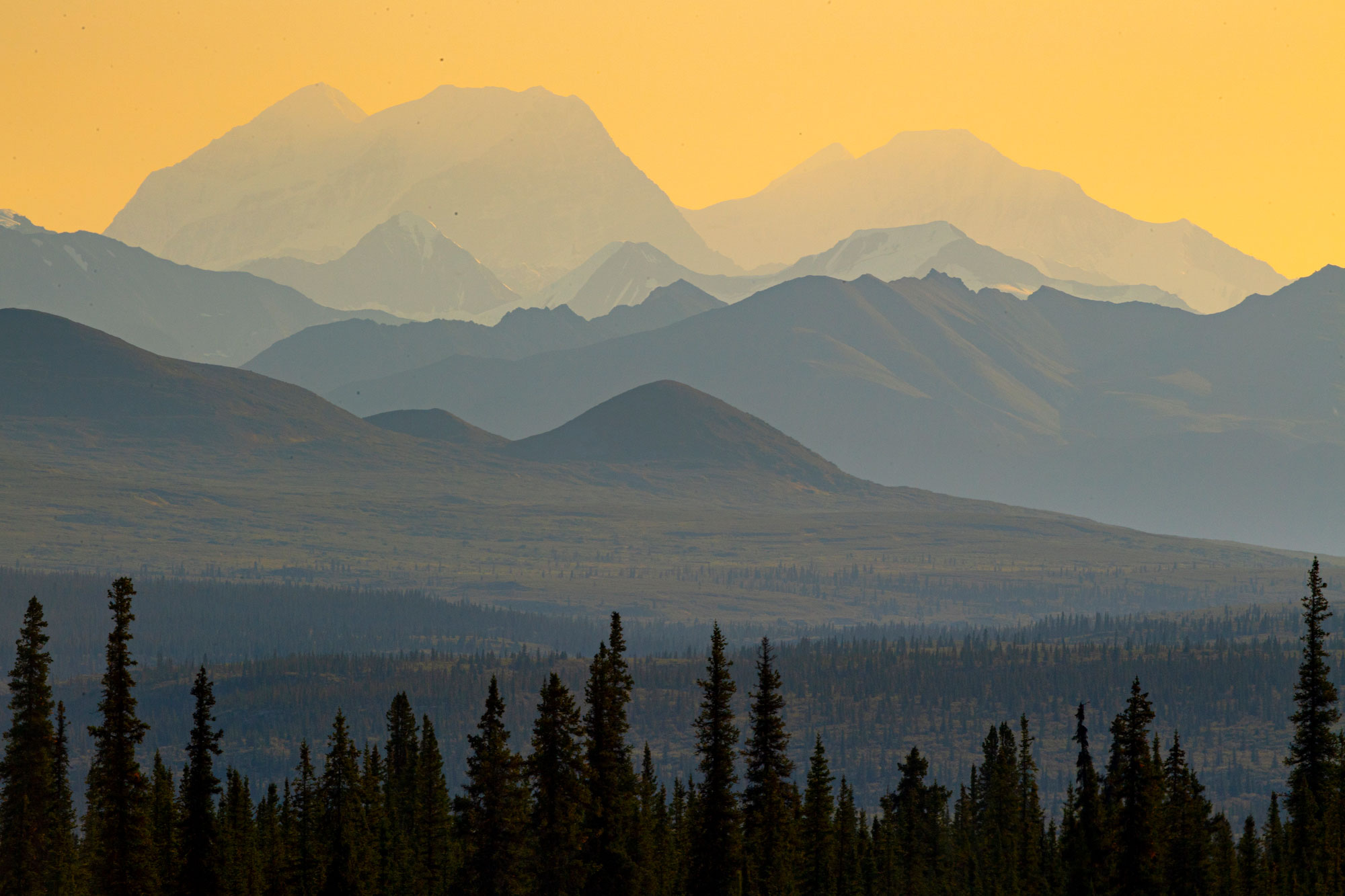
Land
As we go about our daily lives, the carbon-rich soils of the boreal forest and lush rainforests of the tropics are hard at work sucking up carbon dioxide, forming what are known as terrestrial carbon sinks. As a result, every year, land-based ecosystems absorb more CO2 than they emit. From 2007 to 2017, they removed about a third of total anthropogenic emissions from the atmosphere.
But three potential tipping points in the terrestrial system — one in the Arctic, one in the sub-Arctic, and another near the equator — could force the release of huge amounts of carbon stored within those sinks. Once those thresholds are passed, feedback loops might start spiraling, accelerating climate change and reshaping our planet’s forests and soils.
Permafrost
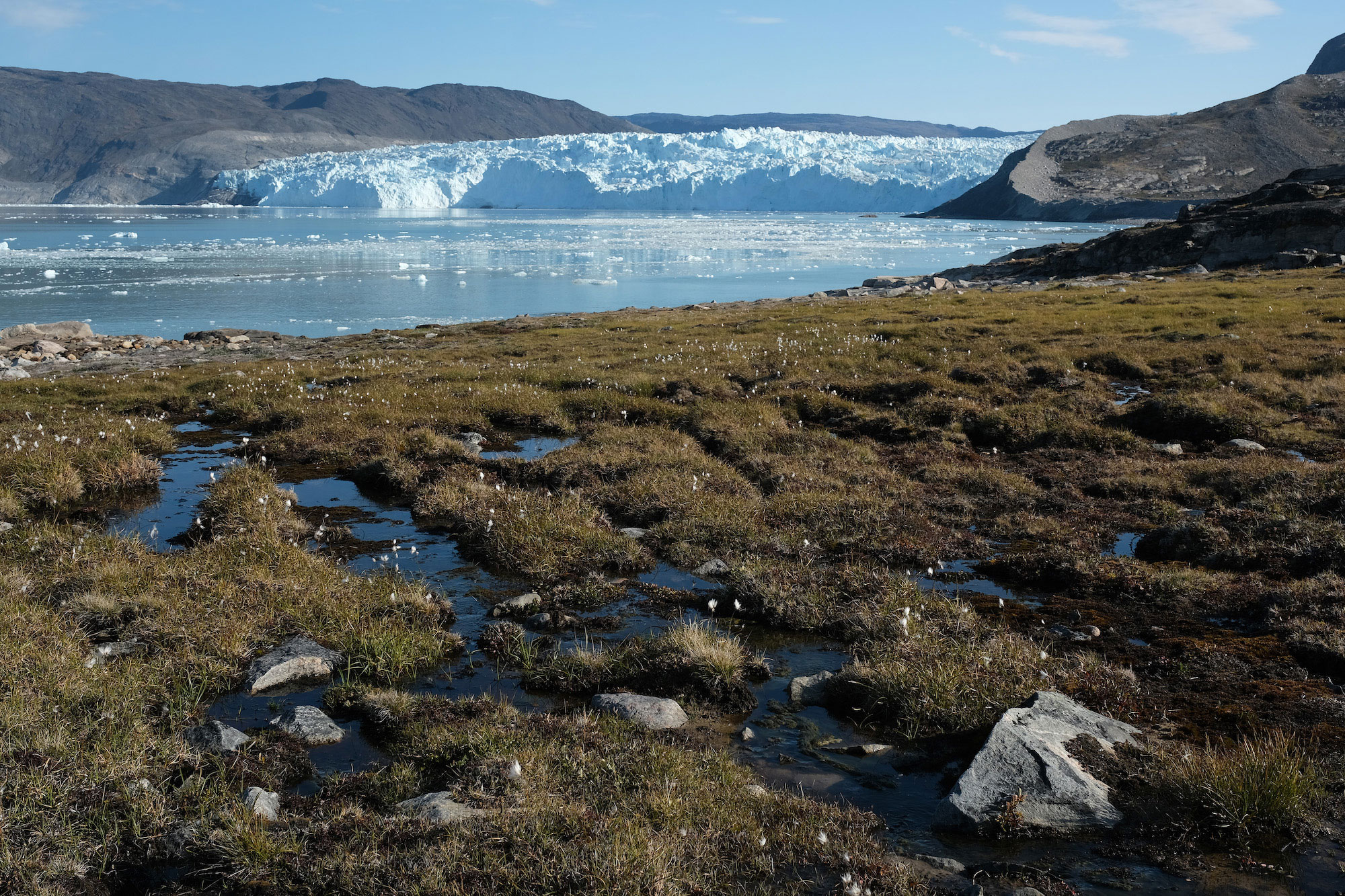
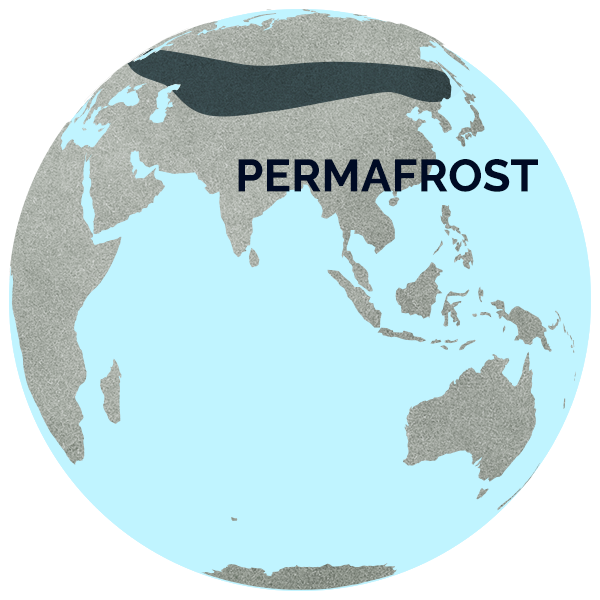
In 2019, Brendan Rogers stumbled into an open wound of our warming planet. He was doing ecological fieldwork in the Alaskan tundra, during a summer so hot that he recalls people walking around in shorts and t-shirts. As he was about to set up a piece of equipment, the ground beneath his feet gave way, sending him falling into an empty crater.
Rogers had just walked into what scientists call a thermokarst feature. They’re “landscape sloughs and slides, features all over the permafrost zone where the ground literally collapses.” Formed by rapid melt, they are the fingerprints of a process taking place throughout the Arctic: permafrost thaw. Permafrost is ancient Arctic soil that usually stays frozen year-round (hence the “perma”).
Permafrost stores almost twice the amount of carbon than is currently in the atmosphere.
These icy soils act a bit like a freezer, slowing the decomposition of dead plants, animals, and microbes.
As the Arctic warms and permafrost soils thaw, the decomposition speeds up, releasing CO2 and methane, a greenhouse gas that is 84 times as potent as carbon dioxide in the short term.
Historically, vast stores of permafrost in the northern Arctic regions of Alaska, Siberia, Canada, and Greenland have contributed to the Earth’s carbon sink, taking in more carbon than they emit every year, thanks to the growth of carbon-eating lichens and mosses on the surface. But the effects of thaw might already have flipped the permafrost region from carbon sink to source. An international team of scientists estimated that during each winter from 2003 to 2017, Arctic permafrost regions lost 1.7 billion metric tons of carbon, while only storing an average of 1 billion metric tons of carbon each summer.
The National Oceanic and Atmospheric Administration’s Arctic Report Card for 2019 found that the permafrost region has already started to lose more carbon than it captures — causing a net 300 to 600 million metric tons of carbon to be released into the atmosphere each year. (That’s more than five times the emissions New York City generates in a year.) The data collected for the report card “has convinced me that this feedback has already started,” says Ted Schuur, one of the report card’s authors and a climate scientist at Northern Arizona University.
Over the next 300 years, worst-case scenario models predict that 208 billion metric tons of carbon could be released through gradual permafrost thaw, about 15 percent of what is currently stored. But it could also take place abruptly; sudden thaw in features like lakes, wetlands, and hills, which produce formations like the crater Rogers fell into, might lead to an additional 60 to 100 billion metric tons of CO2 emissions. That doesn’t take into account more intense wildfires, which combust the carbon stored in permafrost soils and accelerate thaw. All these processes feed into an accelerating feedback loop triggering more warming and more permafrost loss.
One reason the loss of so much permafrost is so concerning to scientists is that it’s irreversible. The carbon buried across the Arctic tundra took millennia to accumulate. Once it’s gone, Lenton says, there’s no getting it back.
Boreal forest
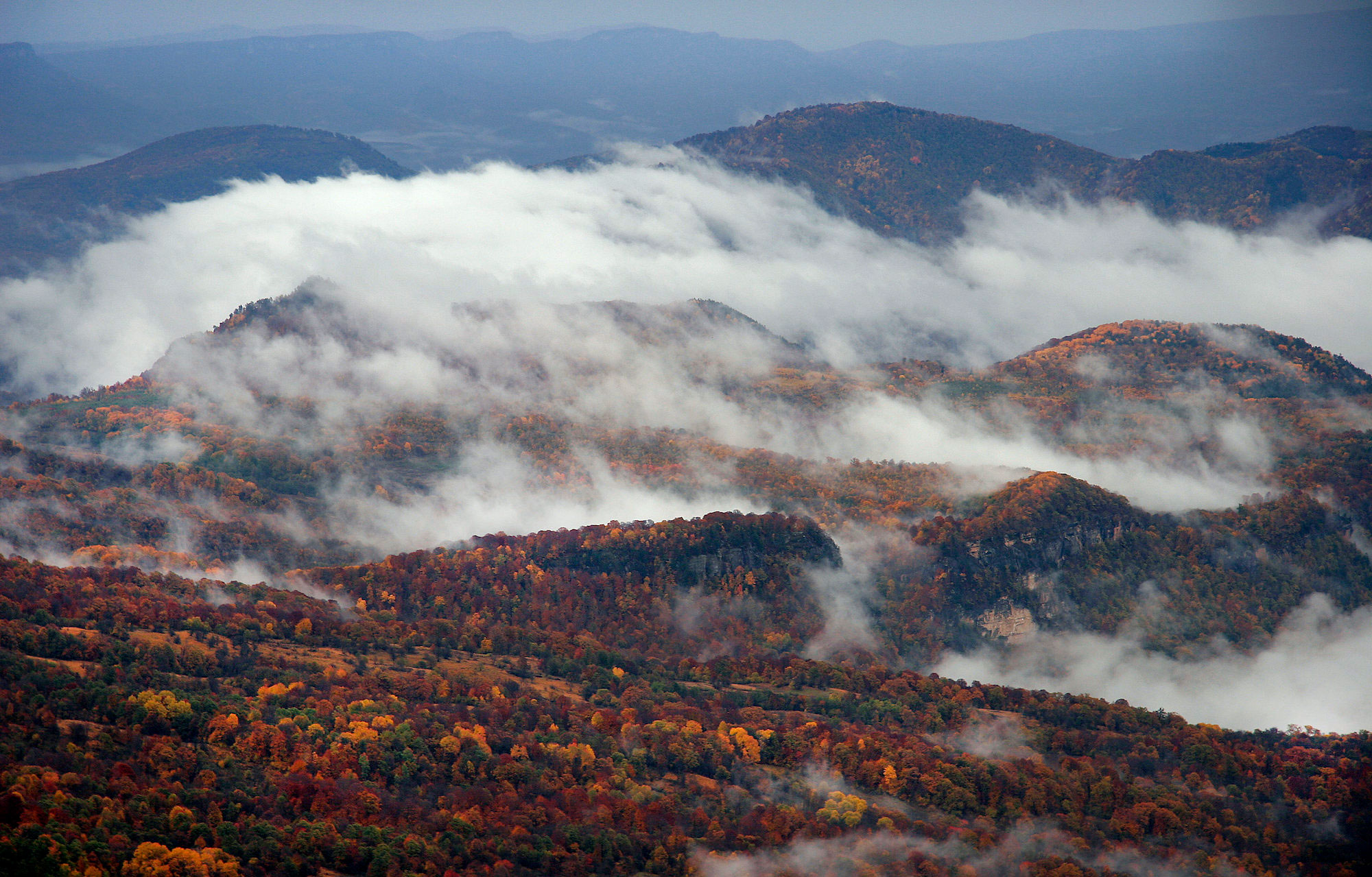
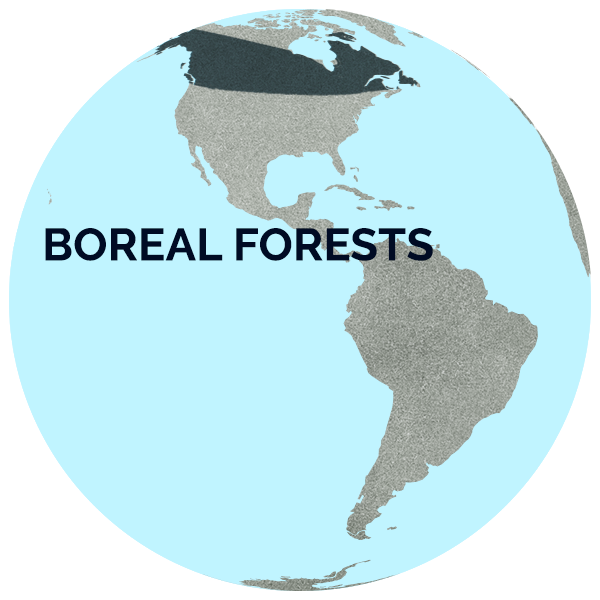
In the summer of 2014, the normally bright midday skies of Canada’s Northwest Territories turned pitch black. After blood-red sun and weeks of thick smoke, Jennifer Baltzer watched as ash rained down over the little town of Yellowknife, where she lived and worked researching boreal forest ecosystems — a band of coniferous forest that circles the globe, right below the Arctic. That year hosted a particularly devastating wildfire season — the one road to Yellowknife was closed for three weeks, with no food coming in or out. For days, a huge cloud of smoke hung across the lake near where her family lived.
As Baltzer watched the forest burn from her home, with her kids sheltered inside, she was aware she was living in a region that is being reshaped by climate change. “The air quality was so bad that we couldn’t take the kids outside,” she recalls. “It was really hard to be outside. You actually felt physically ill.”
The boreal forest spans 1.5 billion acres around the planet, more than half the area of Europe, spread across northern Russia and Canada. It’s also the largest carbon storage reservoir on land, containing 30 to 40 percent of all carbon sequestered on land, and takes up slightly more carbon than it emits every year. Some of this carbon is kept above ground, in the trees, but a large chunk is invisible to the naked eye — about 85 percent of it is locked away in cold, wet soils. Over time, moss and slowly decomposing vegetation form layers of carbon-rich soil known as peat. In some regions where it’s cold enough, the peat is largely permafrost.
But the boreal forests are changing. Fire is part of the natural rhythm of boreal forests, and many tree species within them are adapted to it. But as conditions become warmer and drier, wildfires are happening more frequently and burning over greater areas, threatening the vast reserves of carbon stored in the soils of the boreal region and potentially transforming the forest into grassland or tundra.
The 2014 wildfires in the Northwest Territories that Baltzer lived through burned 8.6 million acres of boreal forest that season alone (compared to the usual average of 1.5 million acres), releasing 94 million metric tons of CO2. The trend has only continued — the summer of 2020 was a record year for wildfires in Siberia, with 26.9 million acres of forest torched as temperatures reached over 100 degrees F in parts of the Arctic. As wildfires accelerate, researchers fear that carbon emissions from the fires could threaten the region’s ability to store more carbon than it emits — and eventually, flip it to a source of carbon emissions.
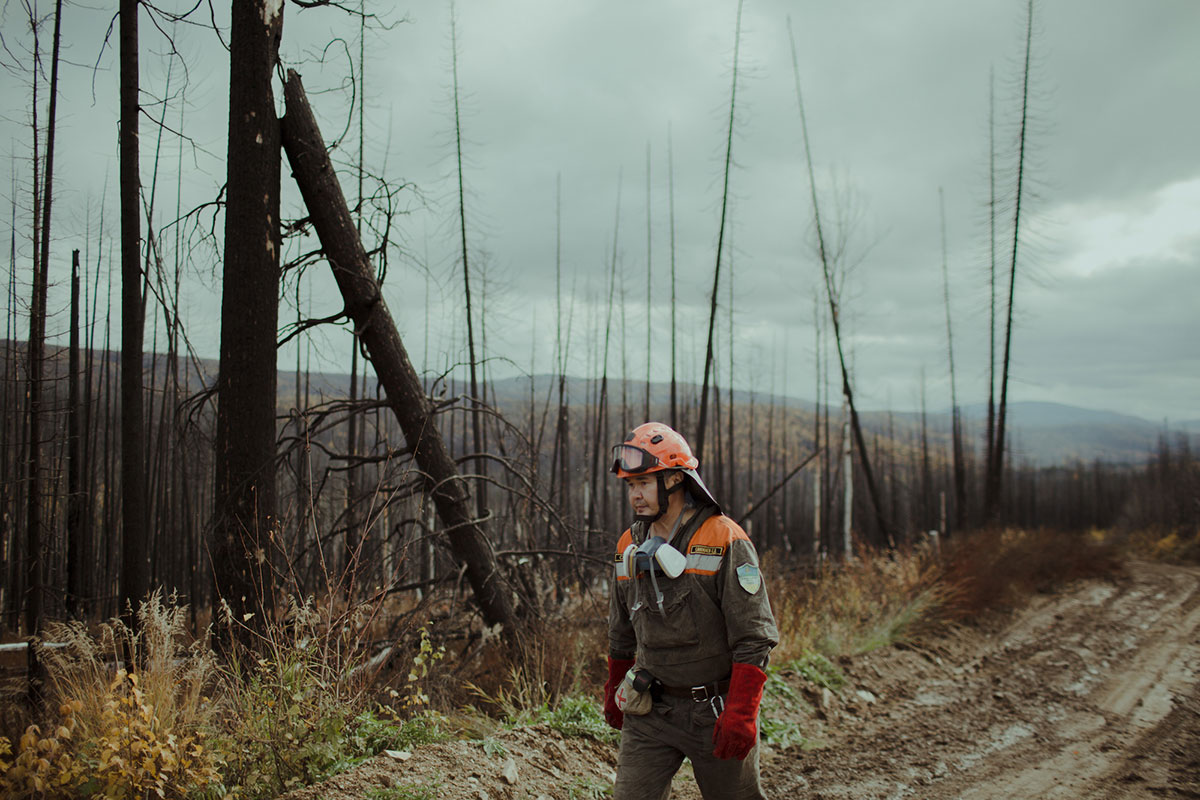
The winter following the 2014 blazes, some fires were still smoldering in the soil, and Baltzer could see them popping up occasionally through the snow – a phenomenon known as “zombie fires.” Her team studied the impacts of that wildfire season on carbon that had previously accumulated in soils, known as “legacy carbon.” It found that the 2014 wildfires burned older and deeper carbon reserves, releasing them into the atmosphere.
That’s one part of how the tipping point works in the boreal forest: As the climate warms, wildfires intensify, releasing more carbon, further accelerating warming, Baltzer explains. That’s not the only feedback at play. As fires return more frequently, forests might fail to recover and slowly morph into grassland or tundra, reducing the amount of carbon stored aboveground. And as warming lures pests like bark beetles northward, it also threatens the well-being of the forests and the release of the carbon stored within them — another potential reinforcing loop.
There are other feedbacks, however, that could help stabilize the system. A study charting the regrowth of Alaskan forests following wildfires found that tree species in the region shifted from black spruce to deciduous trees — allowing the regenerated forests to store even more carbon than the old versions. That transition could mean that over time, the carbon impacts of forest fires could be less severe than previously believed. Baltzer says that similar transitions after fire could be taking place across the North American boreal region. These findings, she explains, “point to broader resilience of that particular function of the system.”
Understanding how these different feedbacks might shape the future of the boreal forest and its vast reserve of carbon is a massive scientific undertaking. Scott Goetz is the leader of NASA’s Arctic-Boreal Vulnerability Experiment, a group of scientists keeping tabs on the vital signs of the region, monitoring, among other things, shifts in how the forests are storing and releasing carbon. His team uses field measurements, data from aircraft flown over the forest, and satellites to paint a picture of how much carbon boreal forests take up and releases every year. Those measurements then inform models of the region’s future.
Goetz says that in many ways the multiple feedbacks at play make predicting what will happen “a hellishly complicated problem.” Because of this, Goetz says he doesn’t have a clear answer about if, when, and how fast the system could cross a tipping threshold. “I don’t think we actually know.”
Amazon rainforest
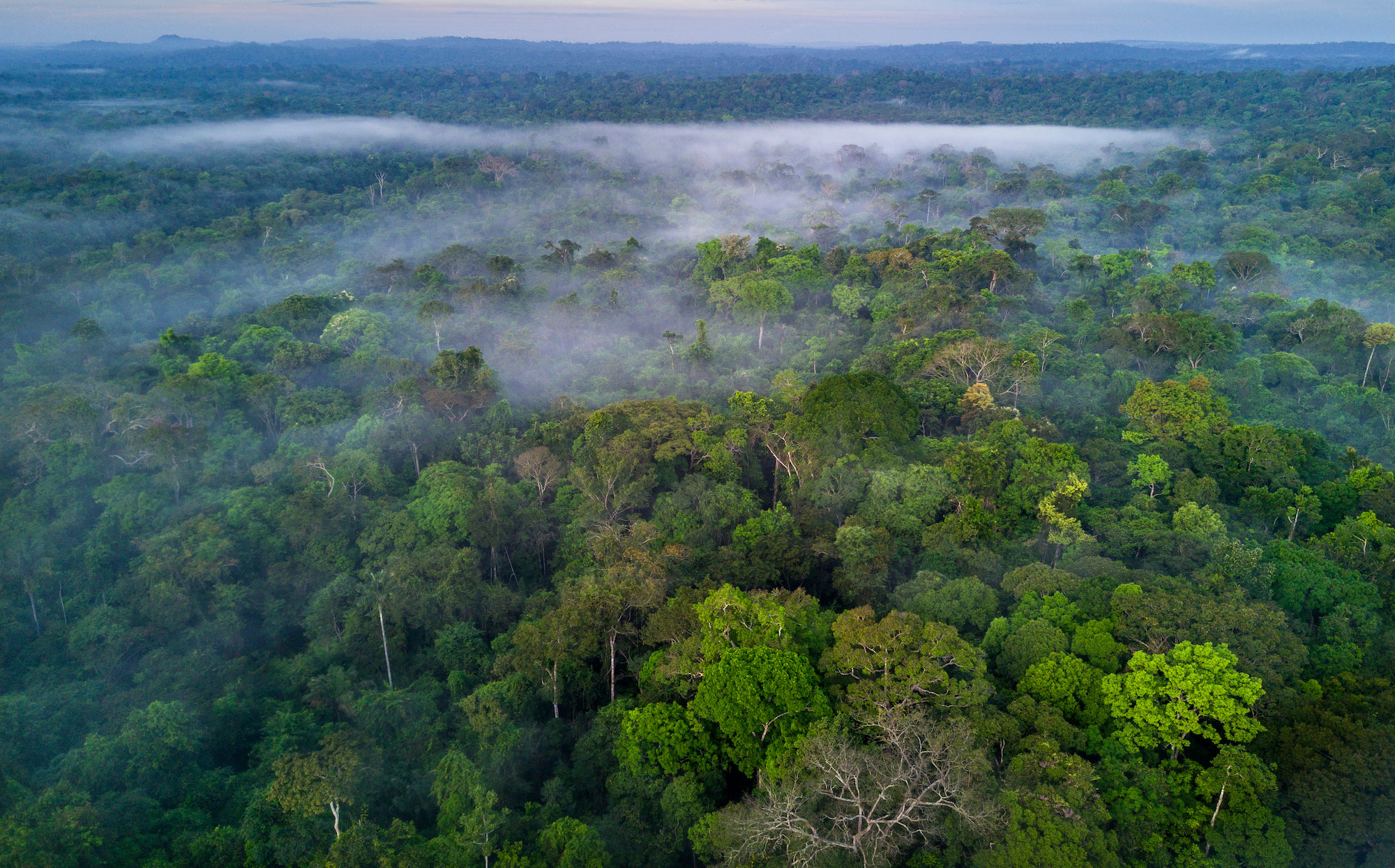
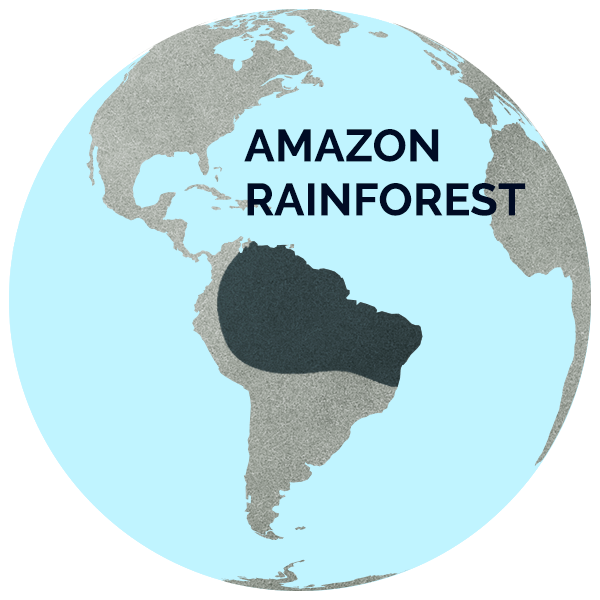
David Lapola has worked in the Amazon rainforest for many years, but September of 2015 sticks out in his memory. He was teaching a field course at a research station some 40 miles north of Manaus, in the center of the Amazon basin. That month was extremely hot and dry, and Lapola noticed how it had sucked the moisture out of the forest. He recalls that the top 20 inches or so of the soil was bone dry — and this was in the central Amazon, the world’s largest rainforest, which normally gets almost 10 feet of rain every year.
“I’ve never seen it like that, neither before nor later on,” Lapola says. “I remember seedlings drying out and dying, small saplings getting drier, the leaves browning.”
Lapola was witnessing first-hand the impacts of a devastating El Niño — a naturally occurring climate pattern, worsened by global warming, that brought unusually dry and hot conditions to the Amazon that year. El Niño-fueled droughts kill trees and suppress growth across the Amazon. Dead trees then release the carbon stored within them, and decreased tree growth means less carbon stored across the system as a whole. The result: The 2015 El Niño drought temporarily turned rainforests from carbon sinks into carbon sources, adding about 2.5 billion tons of carbon to the atmosphere.
That could be a preview of what’s to come. The Amazon rainforest, known commonly as the lungs of the world, holds an estimated 150 to 200 billion metric tons of carbon in its vast reserves of tree and plant mass. Historically, it has represented around a quarter of the world’s terrestrial carbon sink. But the Amazon, like so many other places on Earth, is getting hotter and drier. Over the past century, the temperature in the region has risen by 1 to 1.5 degrees C (1.8 to 2.7 degrees F), and in some places, the dry season has lengthened from four to nearly five months.
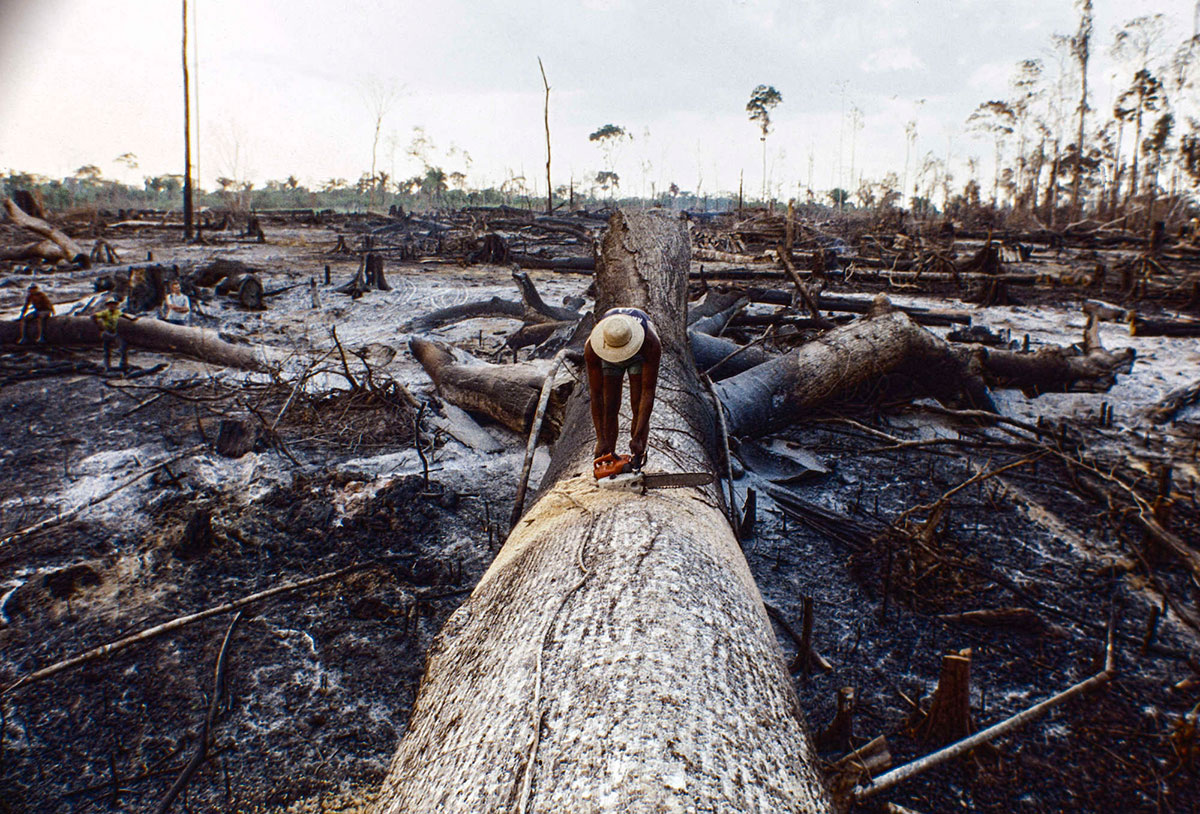
All this has affected what Lapola calls tree demography — how long trees live, their mortality rates, and the growth of new trees. Though higher levels of CO2 in the atmosphere have caused tropical trees to take up more of the greenhouse gas through photosynthesis, an effect known as “carbon fertilization,” the Amazon carbon sink declined by a third from 2005 to 2015 when compared to the 1990s, mostly a result of increased tree mortality, and a fifth now acts as a carbon source. Now, some models predict that the Amazon will become a permanent source of carbon emissions by 2035, further contributing to climate change.
Climate change isn’t the only factor that might push the Amazon toward a tipping point; deforestation also plays a role. Cattle ranchers and farmers have been cutting down large swaths of the rainforest, carving out a portion roughly the size of Connecticut last year. Much of the moisture in the Amazon comes from the trees themselves. They suck up water from the soil through their trunks — like liquid through a straw — and exhale it into the atmosphere through little pores on the undersides of leaves in a process known as transpiration. Transpiration cools the rainforest and produces rainfall. So if the forest is cut down, the surrounding area dries out.
In 2018, Thomas Lovejoy, an environmental scientist at George Mason University in Virginia, and Carlos Nobre, a senior scientist at the Institute of Advanced Studies at the University of São Paulo in Brazil, raised the alarm, estimating that if 20 to 25 percent is deforested, a tipping threshold may be crossed, transforming the Amazon into a savanna. That’s an alarming estimate, given that 15 to 17 percent of the Amazon has already disappeared, with Brazil under nationalist leader Jair Bolsonaro leading tropical forest losses worldwide in 2019. The country led the world in losing tropical forest again in 2020. Lapola says that in the Amazon, “deforestation comes together with global climate” and threatens to push the region past a dangerous tipping point, a risk not just for the health of the rainforest but for the whole planet.
What can we do?
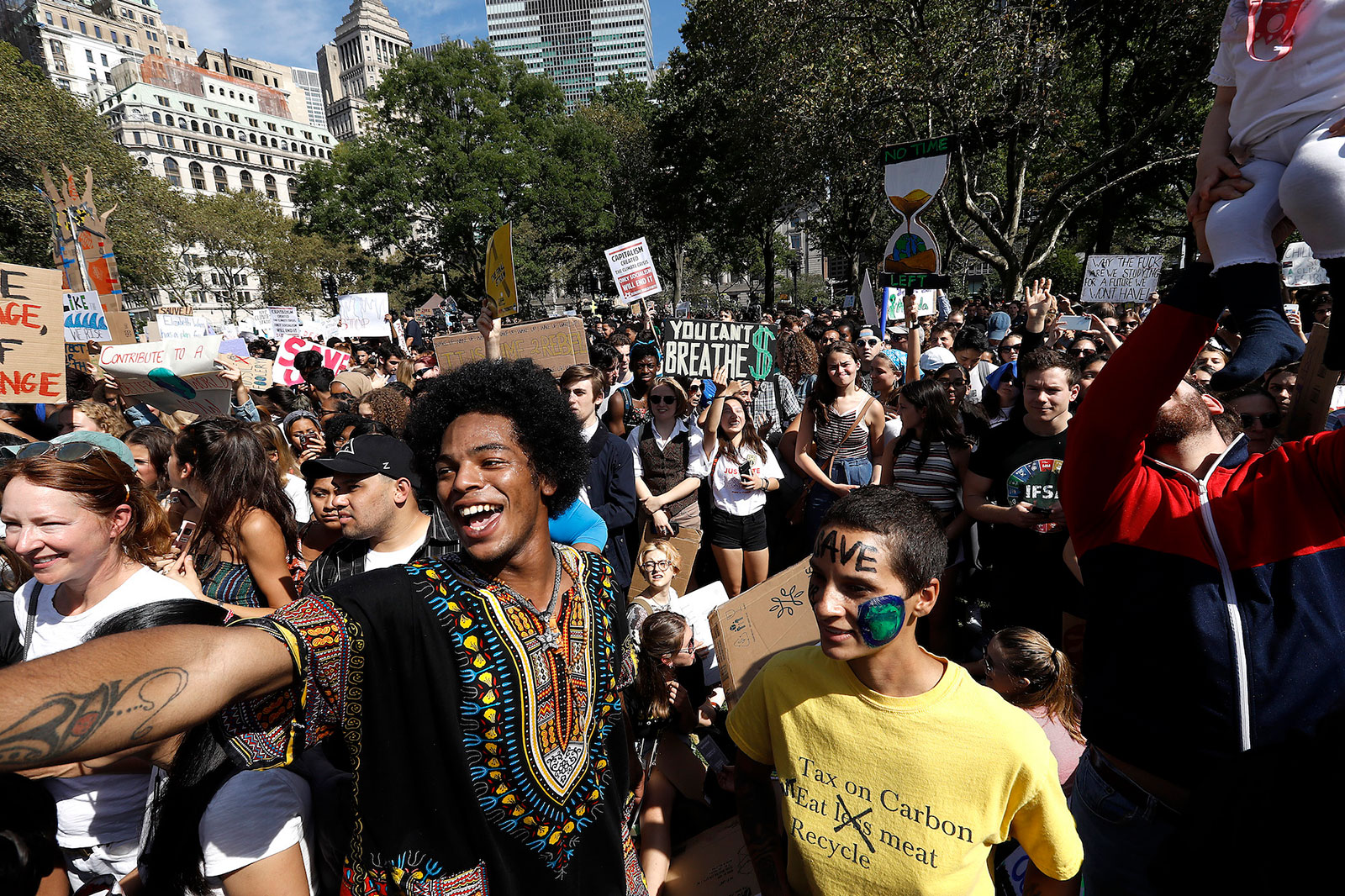
As coral reefs dissolve, Antarctica melts, and vast swaths of rainforest disappear, the world already seems to be headed down a dark path: 2 or 3 degrees C (3.6 or 5.4 degrees F) of warming; land, sea, and ice fundamentally transformed; and the consequences playing out on coastlines and in city neighborhoods thousands of miles away.
But Jacquelyn Gill, the University of Maine paleoclimatologist, does worry that too much focus on tipping points could backfire. It’s a sentiment echoed by the glaciologist Twila Moon. Tipping points are so scary that they could feed into a narrative of hopelessness. “We may not be able to predict exactly when some of these tipping points occur, but what we can do is control our actions, take ownership of our emissions,” Gill says.
And there are reasons for optimism. A few researchers have begun to study another set of tipping points — a group that, instead of spiraling the planet into an increasingly dangerous state, could help shift it back into balance. These so-called “social tipping points” follow the same basic principle as their counterparts in the natural world: First, change happens slowly, then all at once.
In 1907, some 140,000 Americans had a registered automobile; others got around cities by horse-drawn vehicles, bicycles, and trolley cars. By 1917, however, thanks to plummeting price tags for automobiles, there were almost 5 million cars on American roads. A more recent example: In 2003, no state in the country legally recognized gay marriage. Twelve years later, after a dramatic shift in public opinion and a ruling by the Supreme Court, same-sex marriage was legal in all 50.
“Fast change can happen,” says Ilona Otto, a researcher at the Potsdam Institute for Climate Impact Research in Germany. Otto and 13 other scientists released a paper last year arguing that several such social tipping points could drive a rapid increase in initiatives aimed at cutting carbon dioxide emissions. Some of them are concrete and obvious — a drop in renewable energy prices, for example, such that solar and wind are cheaper than fossil fuels. Others are more abstract, like a shift in public attitudes toward seeing fossil fuels as fundamentally immoral.
Most social tipping points are hard to measure, and even harder to predict. But there are signs that they may be slowly approaching. In 2009, a new solar farm cost 223 percent more than a new coal plant. Today, those numbers have roughly flipped. That means that one of Otto and her colleagues’ key thresholds is within reach: In many regions, renewables are now a cheaper source of energy than fossil fuels.

At the same time, the movement to divest university endowments from fossil fuels, combined with high-profile climate protests by Swedish activist Greta Thunberg and organizing by other young people, has already contributed to a growing sense, especially among younger millennials and Generation Z, that fossil fuel use is unethical. Some people have begun to avoid flying due to “flygskam,” or “flight shame,” over the airline industry’s sky-high carbon footprint; even oil and gas giants now feel the need to advertise their promises to bring their emissions to zero by 2050. In the U.S., youth activism sparked a conversation — and then a movement — around the idea of a clean energy-focused Green New Deal.
It’s hard to say whether these trends will continue. But they provide reason to hope that we’ll hit these more virtuous tipping points before the catastrophic ones. “Hopefully, these tipping points will start to accumulate,” Otto says, “and then come together as an avalanche.”
- This story was reported and written by Alexandria Herr, Shannon Osaka, and Maddie Stone. Videos were produced by Daniel Penner and Jesse Nichols. Jacky Myint handled design and development. Teresa Chin led the art direction. Illustration was done by K. Amelia Bates. Jacob Banas, Mignon Khargie, Myrka Moreno, and Christian Skotte did promotion and additional production.
- This project was edited by Katherine Bagley, Matt Craft, Maddie Stone, and Nikhil Swaminathan. It was copy edited by Kate Yoder and fact checked by Ysabelle Kempe.
